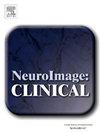脊髓性肌肉萎缩症 2 型和 3 型患者的脑磁共振成像。
IF 3.4
2区 医学
Q2 NEUROIMAGING
引用次数: 0
摘要
背景和目的:近端脊髓性肌萎缩症(SMA)是由于缺乏普遍表达的存活运动神经元蛋白所致。虽然它主要是一种遗传性下运动神经元疾病,但其他器官也可能出现异常。据报道,严重的 SMA 患者会出现脑部异常和认知障碍。我们的目的是利用核磁共振成像系统地研究 SMA 的大脑结构:我们在 3 T 磁共振成像扫描仪上采集了未经治疗的 SMA 患者、年龄和性别匹配的健康对照组以及患有其他神经肌肉疾病的疾病对照组的高分辨率 T1 加权图像。我们对皮层厚度(CT)进行了顶点全脑分析和感兴趣区分析,并对丘脑进行了容积分析,使用多元线性回归模型和 Wald 检验比较了患者和对照组的研究结果。我们将结构异常与哈默史密斯功能运动量表扩展版(HFMSE)和SMA功能评定量表(SMA-FRS)评估的运动功能相关联:我们纳入了 30 名年龄在 12-70 岁之间的 SMA 2 型和 3 型患者、30 名年龄和性别匹配的健康对照者以及 17 名疾病对照者(患有远端 SMA、遗传性运动和感觉神经病变、多灶性运动神经病变、进行性肌萎缩和节段性 SMA)。我们发现,与健康对照组相比,SMA 患者在中央前叶、中央后叶和内侧眶额叶以及颞极的 CT 值降低(平均差异分别为-0.059(p = 0.04);-0.055(p = 0.04);-0.06(p = 0.04);-0.17 mm(p = 0.001))。在SMA 2型患者中,前中央回和颞极的差异最为明显(平均差异为-0.07(p = 0.045);-0.26 mm(p 3(p = 0.03)),丘脑前核、腹侧核和层内核的差异也最为明显(平均差异为-9.9(p = 0.02);-157(p = 0.01);-24.2 mm3(p = 0.02)),这些体积与运动功能呈正相关:结论:核磁共振成像显示,SMA 2 型和 3 型患者大脑皮层和丘脑的运动区和非运动区发生了结构性变化,这表明 SMA 的病理变化并不局限于运动神经元。本文章由计算机程序翻译,如有差异,请以英文原文为准。
Brain magnetic resonance imaging of patients with spinal muscular atrophy type 2 and 3
Background and objective
Proximal spinal muscular atrophy (SMA) is caused by deficiency of the ubiquitously expressed survival motor neuron protein. Although primarily a hereditary lower motor neuron disease, it is probably also characterized by abnormalities in other organs. Brain abnormalities and cognitive impairment have been reported in severe SMA. We aimed to systematically investigate brain structure in SMA using MRI.
Methods
We acquired high-resolution T1-weighted images of treatment-naive patients with SMA, age- and sex-matched healthy and disease controls with other neuromuscular diseases, on a 3 T MRI scanner. We performed vertex-wise whole brain analysis and region of interest analysis of cortical thickness (CT), and volumetric analysis of the thalamus and compared findings in patients and controls using multiple linear regression models and Wald test. We correlated structural abnormalities with motor function as assessed by the Hammersmith Functional Motor Scale Expanded (HFMSE) and SMA Functional Rating Scale (SMA-FRS).
Results
We included 30 patients, 12–70 years old, with SMA type 2 and 3, 30 age- and sex-matched healthy controls and 17 disease controls (with distal SMA, hereditary motor and sensory neuropathy, multifocal motor neuropathy, progressive muscular atrophy and segmental SMA). We found a reduced CT in patients with SMA compared to healthy controls at the precentral, postcentral and medial orbitofrontal gyri and at the temporal pole (mean differences −0.059(p = 0.04); −0.055(p = 0.04), −0.06(p = 0.04); −0.17 mm(p = 0.001)). Differences at the precentral gyrus and temporal pole were most pronounced in SMA type 2 (mean differences −0.07(p = 0.045); −0.26 mm(p < 0.001)) and were also present compared to disease controls (mean differences −0.08(p = 0.048); −0.19 mm(p = 0.003)). There was a positive correlation between CT at the temporal pole with motor function. Compared to healthy controls, we found a reduced volume of the whole thalamus (mean difference −325 mm3(p = 0.03)) and of the anterior, ventral and intralaminar thalamic nuclei (mean differences −9.9(p = 0.02); −157(p = 0.01); −24.2 mm3(p = 0.02) in patients with SMA and a positive correlation between these volumes and motor function.
Conclusion
MRI shows structural changes in motor and non-motor regions of the cortex and the thalamus of patients with SMA type 2 and 3, indicating that SMA pathology is not confined to motor neurons.
求助全文
通过发布文献求助,成功后即可免费获取论文全文。
去求助
来源期刊

Neuroimage-Clinical
NEUROIMAGING-
CiteScore
7.50
自引率
4.80%
发文量
368
审稿时长
52 days
期刊介绍:
NeuroImage: Clinical, a journal of diseases, disorders and syndromes involving the Nervous System, provides a vehicle for communicating important advances in the study of abnormal structure-function relationships of the human nervous system based on imaging.
The focus of NeuroImage: Clinical is on defining changes to the brain associated with primary neurologic and psychiatric diseases and disorders of the nervous system as well as behavioral syndromes and developmental conditions. The main criterion for judging papers is the extent of scientific advancement in the understanding of the pathophysiologic mechanisms of diseases and disorders, in identification of functional models that link clinical signs and symptoms with brain function and in the creation of image based tools applicable to a broad range of clinical needs including diagnosis, monitoring and tracking of illness, predicting therapeutic response and development of new treatments. Papers dealing with structure and function in animal models will also be considered if they reveal mechanisms that can be readily translated to human conditions.
 求助内容:
求助内容: 应助结果提醒方式:
应助结果提醒方式:


